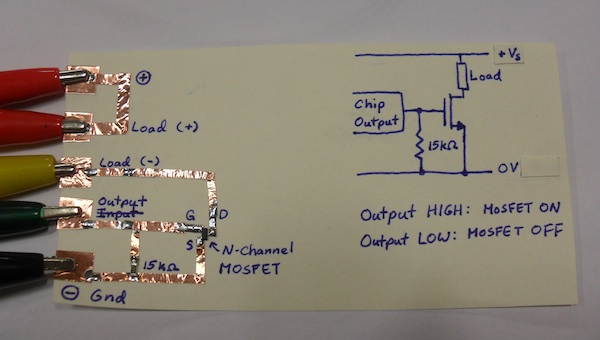Intro to shape memory alloy actuation using Flexinol
Shape memory alloys (SMAs) are metals that change shape when heated up. They are wonderful actuators in that they are light, silent and can be "turned on" by simply running current through. The shape that they change to can also be set, though this process is a bit more tricky. Flexinol is a particular brand of nitinol, which is an SMA made of nickel and titanium, and is pre-set to contract about 10% of its original length when heated.
The Flexinol that I used is from robotshop.com, which provides a useful chart of different wire properties here. The general trends are:
- All wires take about 1 second to heat up and contract
- Higher diameter wires have more pulling force than lower diameter wires
- Higher diameter wires have longer off times (it takes longer for the wire to return to its original, un-contracted shape)
- Higher-diameter wires have lower resistance and draw more power. Thus, they are more likely to overheat and lose its original contraction abilities. Wires that are 0.006" or smaller can be kept on constantly without fear of overheating.
- High-Temperature (90C) wires have faster off-times than Low-Temperature (70C) wires
Since Flexinol draws a lot of current (about 300mA for the diameters I used), you need a strong power supply like a wall supply or a good lithium-ion battery. I've used from 3.7V up to 6V (any more and my Flexinol wires would start overheating). To turn the Flexinol on, I would simply short the ends of the wire to the power. For digital control, I used a standard MOSFET circuit which is a digital switch that can be turned on and off using a microcontroller. The circuit I used is below:

In order from top to bottom, the clips on the left are:
- + of power supply (red)
- one end of Flexinol (red)
- other end of Flexinol (yellow)
- Input to MOSFET (green)
- - or ground of power supply (black)
Flexinol is not solderable, so to connect it to the rest of the circuit, I recommend using crimp beads like the ones here. To make a solid connection between the wire and the crimp bead, bend the end of the Flexinol wire into a "u" before inserting it into the crimp bead. Then crimp tightly with a pair of pliers and you will be able to solder to the crimp bead. Make sure that the Flexinol is securely anchored to your mechanism, or else the wire will simply shrink without actually moving your components.
Below is an example mechanism useful for making a piece of paper fold:


Using the MOSFET control circuit and the folding mechanism, I made the following:
Back to index